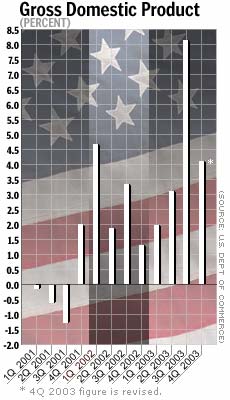NEW YORK (CNN/Money) -
The economy grew at a slightly faster pace in the fourth quarter than initially estimated, the government said Friday, as robust business investment offset sluggish consumer spending and a wider trade gap.
The Commerce Department said gross domestic product (GDP), the broadest measure of the economy, grew at a revised 4.1 percent annual rate in the quarter, compared with its initial estimate of 4 percent.

Economists, on average, expected growth to be revised to 3.8 percent, compared with the sizzling 8.2 percent pace in the third quarter.
An increase in imports, which subtract from GDP, was expected to drag total GDP lower, but business investment was stronger than most economists expected.
"We ended last year with a good bit more momentum on the capital investment front than we thought," said David Resler, chief economist at Nomura Securities. "We have an optimistic view about this year as a whole."
In all of 2003, GDP rose at a pace of 3.1 percent, compared with 2.2 percent in 2002. Most economists expect GDP growth of about 4.6 percent this year, according to many recent polls.
Friday's GDP report was a preliminary number, based on incomplete data. It will be revised at least once, possibly more.
The report, along with separate, stronger-than-expected reports on Chicagoland manufacturing and consumer confidence, at first helped lift stock prices, but those gains were reversed in midday trading. Treasury bond prices rose.
Businesses took up slack from consumers
The department said consumer spending growth, which accounts for more than two-thirds of GDP, was revised up to 2.7 percent from an initially reported 2.6 percent. The pace of growth was a strong 6.9 percent in the third quarter.
| Related stories
|

|
|
|
|
But the surprising upward revision to total GDP was driven by a dramatic rise in business investment, which surged at a 9.6 percent annual rate in the quarter. The Commerce Department's initial estimate was 6.9 percent. Business investment grew at a 12.8 percent pace in the third quarter.
The surge in business investment was driven mainly by a 15.1 percent growth rate in purchases of equipment and software. That pace was initially estimated at 10 percent, compared with 17.6 percent in the third quarter.
Though many economists expect consumer spending will get a boost in the first half of 2004 from income-tax refund checks, they also believe that spending could slow later in the year, meaning businesses will have to provide most of the impetus behind economic growth this year. Friday's report offered some hope that business spending has gained momentum.
"We've been talking for a long time about capital spending growth being a key component of the sustainability of this recovery," said Joshua Feinman, chief economist at Deutsche Bank Asset Management. "You have to be encouraged about what we've seen."
Adding nearly a full point to fourth-quarter GDP was stronger-than-expected growth in business inventories, which rose at a $14.9 billion rate in the quarter, following a decrease of $9.1 billion in the third quarter.
While higher inventory levels could mean businesses have less need to boost production in the first quarter, analysts nevertheless took heart since shelf restocking is a sign of growing business confidence.
"If companies are willing to step up capital spending and increase the level of inventories they are holding, we have to believe that a rise -- even if it's gradual -- in the pace of hirings cannot be too far away," said Anthony Chan, chief economist at Banc One Investment Advisors.
Hiring, inflation still low
Despite several consecutive quarters of growth, payrolls are still 2.3 million jobs lower than they were in early 2001, when the last recession began, the longest stretch of job market pain since World War II.
Many economists believe a job rebound is coming, but some of the recent technology-driven gains in productivity -- a measure of output per worker hour -- could linger, keeping that rebound from being as strong as usual.
"To get faster job growth, we're going to need either faster aggregate demand, which seems hard to fathom, or we're going to need some diminution of the recent extra cyclical pop in productivity," said Deutsche Bank's Feinman, adding, "When will that start? Anybody who says they know is lying."
Anemic hiring has kept wage growth slow, also keeping a lid on inflation. The GDP report's personal consumption expenditure deflator, a key measure of consumer inflation closely watched by the Federal Reserve, rose at a paltry 0.7 percent rate in the fourth quarter and 1.2 percent in all of 2003, excluding volatile food and energy costs.
With inflation at bay, the Federal Reserve decided in January to keep its target for a key short-term interest rate at the lowest level in more than 40 years. Fed officials have promised repeatedly to be patient in raising rates, and most economists expect them to stay on hold through the summer, at least.
An upward revision to the pace of import growth, which subtracts from GDP, kept the total GDP number from being higher. Imports grew at a 16.4 percent rate, up from the 11.3 percent initially estimated, and compared with growth of just 0.8 percent in the third quarter.
Exports grew at a 21 percent pace, evidence the weaker dollar is helping U.S. manufacturers by making American-made goods more competitive overseas.
Housing activity continued at a strong pace in the quarter, driven by the lowest interest rates in a generation. Government spending grew at a 0.8 percent rate in the quarter, compared with a 1.8 percent pace in the third quarter.
Consumer spending was concentrated in disposable goods like food, clothing and gasoline. Spending on durable goods such as cars and refrigerators shrank for the first time since the second quarter of 2000, as consumers dramatically scaled back automobile purchases.
Durable-goods spending edged down 0.1 percent after growing at a whopping 28 percent pace in the third quarter.

|

